In 2021, the International Monetary Fund (IMF) issued a historic allocation of Special Drawing Rights (SDRs) equivalent to $650 billion. These supplementary international reserve assets were allocated to help meet the liquidity bottlenecks facing many countries due to the COVID-19 pandemic. However, because of the IMF’s quota-based system, SDRs primarily flowed to more advanced economies, even though they don’t face the same economic pressure as developing countries. In response, Group of Seven (G7) nations agreed to re-channel $100 billion in SDRs to the countries that need them, roughly 20 percent of those SDRs allocated to G7 countries (G7 2021). China has pledged to provide $10 billion of its SDRs to Africa, at 25 percent of its allocation (Farand 2021).
As a vehicle to facilitate SDR re-channeling, the IMF announced it was looking to establish a ‘Resilience and Sustainability Trust’ (RST). In October 2021, the Group of 20 (G20) also called on the IMF to establish such a Trust, with a very clear mandate of providing climate vulnerable nations with access to short-term and long-term financing in face of the climate crisis. The G20 recognized the need for ‘affordable long-term financing to help low-income countries, small developing states and vulnerable middle-income countries reduce risks to prospective balance of payment stability, including those stemming from pandemics and climate’ in its Rome Leaders’ Declaration (G20 2021).
With respect to climate change, this unprecedented and much needed financing instrument could address a glaring gap in the international finance architecture. At this writing, however, the design particulars of the RST would deem this financing unattractive to much of the IMF membership, essentially locking up billions in climate- and pandemic-fighting resources.
What is more, the IMF has also identified addressing the pandemic and digitalization as two other key objectives of the RST. As the resource requirements to tackle climate change alone are significantly greater than the RST’s expected capitalization at $30 to 50 billion, it must be designed to play a catalytic role. First, the RST needs to be equipped with substantially more resources, including built-in design features that trigger regular replenishments. Second, the IMF will have to work collaboratively with the World Bank and other multilateral development banks (MDBs) to ensure that the RST’s resources have the furthest-reaching impact possible.
The Task Force on Climate, Development and the IMF published an initial policy brief on potential modalities of the RST in October 2021 (Task Force 2021). There, we identified three overarching objectives: the RST should enable countries to respond to climate shocks; catalyze low-cost financing for poorer, climate vulnerable countries; and enhance the ability of emerging market and developing countries to mobilize longer term financing.
Since then, the IMF has put forth several design iterations, each responding to engagement from member states, outside experts and civil society organizations. While the Fund’s thinking has evolved on this issue in the right direction, current RST proposals still fall far short of their promise. This policy brief underscores five design features critical to ensuring the RST can have the transformational impact that developing countries need. The RST should:
- Have broad eligibility criteria to ensure that countries vulnerable to physical and transition risks of climate change have access.
- Offer concessional terms, short- and long-term financing and access that is not conditional upon having an existing IMF program.
- Prioritize country ownership and avoid conditionalities. Onerous conditionalities will dampen demand and undermine the effectiveness of the RST.
- Ensure collaborative governance by actively involving the World Bank and other MDBs, as well as outside experts and civil society. MDBs’ experience with climate programming and longer-term investments and disaster risk financing will be vital.
- Build for scale. The RST should be scaled in a manner commensurate to the needs of member states in building resilient and sustainable economies. This should be based on climate-risk adjustments depending on the temperature trajectory.
At the Paris Peace Forum in November 2021, IMF Managing Director Kristalina Georgieva said the design of the RST would be ready for IMF Board approval by the 2022 IMF and World Bank Spring Meetings, with the goal of making the RST operational by the Annual Meetings in the fall (Georgieva 2021). There is still time to improve the design of the RST to make it an important, transformational instrument for resilience and sustainability in the world economy.



